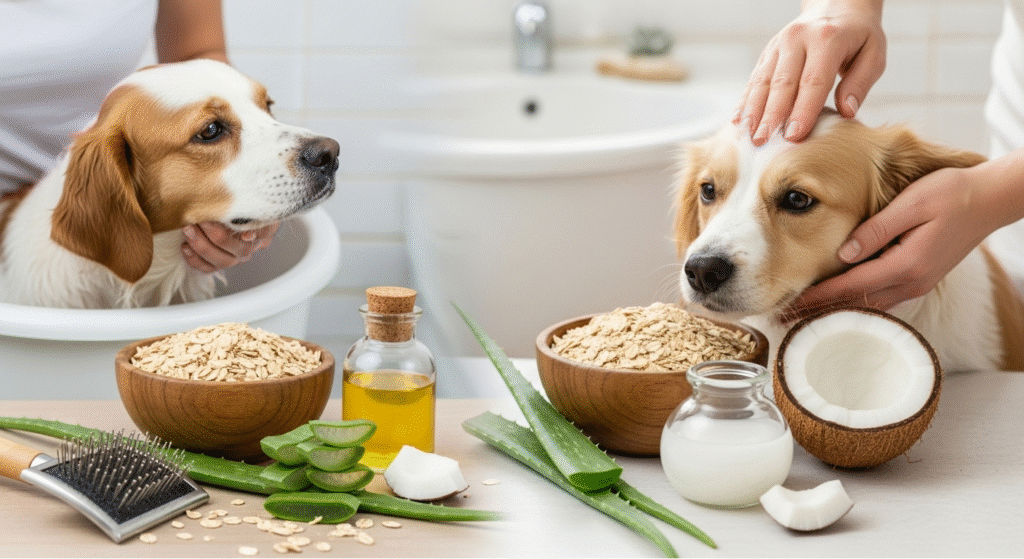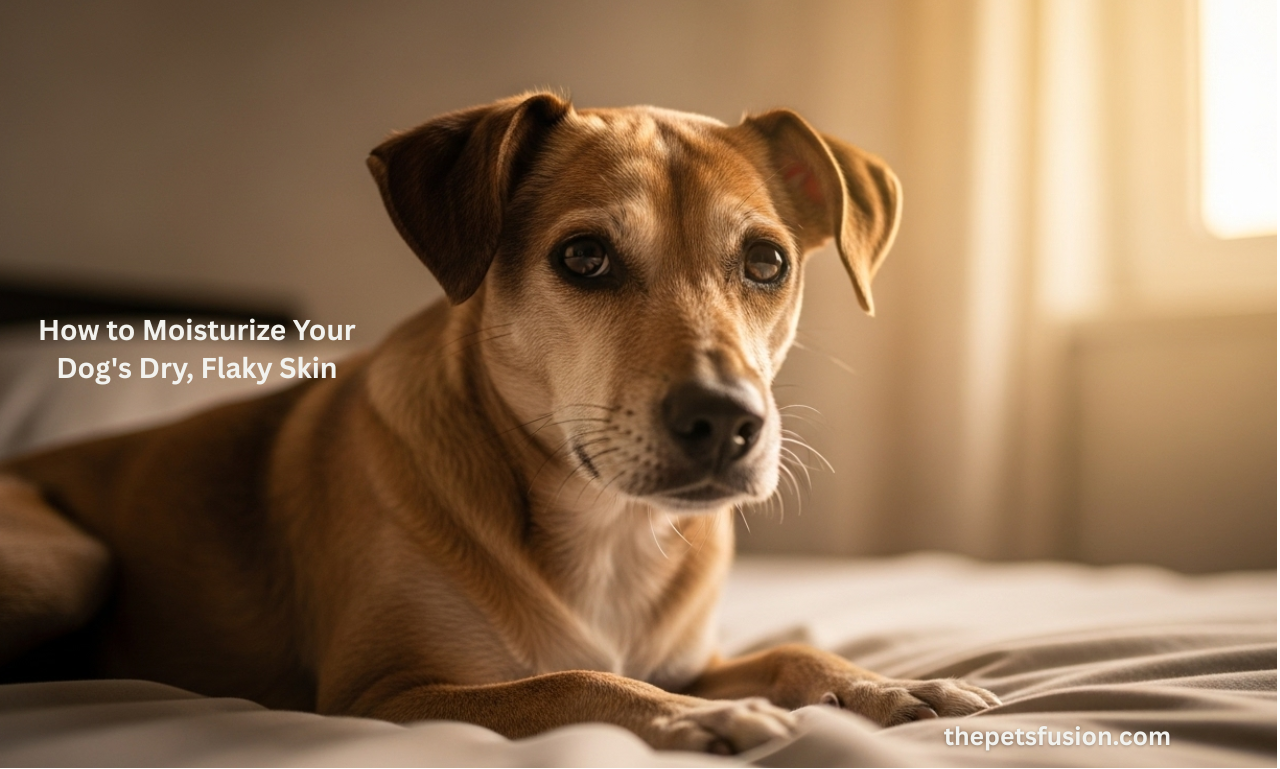Luckily, many mild cases of dry skin can be treated right at home—with the right tools and know-how. Just like people, dogs can experience dry, flaky skin—especially during the winter or in dry climates. Maybe your pup is suddenly scratching more, or you’ve noticed little white flakes on their bed or fur. The good news? If there aren’t any severe symptoms, you can often handle it at home with a few gentle changes to your dog’s routine. There are several reasons why your dog might be experiencing dry skin, and identifying the root cause is the first step toward finding relief. Let’s break down why it happens, how to moisturize your dog’s dry, flaky skin, and when it’s time to call your vet.
Common Causes of Dry Skin in Dogs
Dry Air
The most frequent culprit? Dry air—especially in the colder months when heaters are running full blast. Just like your own skin, your dog’s skin needs moisture to stay supple and healthy. When the humidity drops, their skin can lose that moisture and become itchy or flaky.
Try using a humidifier in your home, especially in rooms where your dog spends the most time. It can improve skin comfort for both pets and people.
Nutritional Deficiencies
A well-balanced diet is key to a healthy coat. If your dog’s food lacks essential fatty acids, their skin might suffer. Double-check that their food meets AAFCO standards, which ensures it has the proper nutrients.
Feeding a homemade diet? Work with a veterinary nutritionist to create a safe, complete recipe—don’t rely on random online sources. For many dogs, omega-3 and omega-6 fatty acid supplements can have a significant impact on their skin and coat. These are available in liquid or capsule form, but always choose products approved by the National Animal Supplement Council or recommended by your vet.
Bathing Too Frequently
Too many baths—especially with harsh shampoos—can strip your dog’s natural oils, leaving their skin unprotected and dry. Most dogs only need the occasional bath (think: a few times per year), unless a vet suggests otherwise.
If your dog requires more frequent baths due to odor or skin issues, consult your veterinarian. You might need a medicated shampoo or be dealing with an underlying skin condition. Oatmeal-based shampoos are a great option for soothing dry, irritated skin and are safe for most dogs. Just be sure to rinse thoroughly—leftover residue can make things worse.
Parasites & Medical Conditions
Sometimes, dry, flaky skin can be a sign of something more serious. Parasites like mites and ringworm can cause intense skin irritation. Common parasite-related skin conditions include:
- Seborrheic dermatitis
- Ringworm
- Demodectic mange
- Cheyletiella (walking dandruff)
Beyond parasites, chronic conditions like food allergies, environmental allergies, Cushing’s disease, and hypothyroidism can also lead to dry skin—usually alongside other symptoms.
Call your vet if your dog has:
- Hair loss
- Scabs or open sores
- Pustules or greasy skin
- Constant licking or chewing
- Ear infections
- Lethargy or weight changes
- Vomiting or diarrhea
These signs suggest a more serious issue that requires veterinary attention.
At-Home Remedies for Dry Dog Skin

If your dog’s symptoms are mild and they seem comfortable, you may be able to treat the dryness at home with a few easy remedies:
- Run a humidifier to combat dry indoor air, especially in winter.
- Start a fatty acid supplement (like omega-3 and omega-6). Look for products with the NASC seal or your vet’s recommendation.
- Bathe with an oatmeal-based shampoo for a gentle, soothing clean. Always rinse well!
- Try coconut oil: Some pet parents find success rubbing a small amount into their dog’s skin or adding a tiny bit to their food (ask your vet first).
If you find yourself repeating these steps often or your dog’s symptoms don’t improve, schedule a vet appointment. Persistent dry skin can be a symptom of a more complex underlying condition.
Final Thoughts
Dry, flaky skin doesn’t have to make your dog uncomfortable—or you worried. With a little investigation and a few gentle changes, most cases can be soothed right at home. But always listen to your dog (and your vet). If something seems off, it’s worth checking out. Your dog deserves to feel as good on the outside as they do on the inside—soft, happy, and loved.
Frequently Asked Questions
1. What can I put on my dog’s dry, flaky skin?
You can use an oatmeal-based dog shampoo, vet-approved coconut oil, or omega-3 and omega-6 supplements. Always consult your veterinarian before applying any topical treatment to ensure it’s safe for your pet.
2. Can I use human lotion on my dog?
No. Most human lotions contain ingredients that can be harmful or toxic to dogs if ingested. Stick to pet-safe moisturizers or products recommended by your veterinarian.
3. Why does my dog have dandruff or flaky skin?
Common causes include dry air, excessive bathing, poor nutrition, or underlying health conditions such as allergies or parasites. Identifying the root cause is key to proper treatment.
4. How often should I bathe a dog with dry skin?
Generally, dogs with dry skin should be bathed no more than once a month—unless otherwise advised by your vet. Use a moisturizing or oatmeal-based shampoo and rinse thoroughly.
5. Do omega-3 supplements help with dry skin in dogs?
Yes, omega-3 fatty acids (like those from fish oil) are proven to improve skin hydration and reduce flakiness in dogs. Choose a high-quality supplement with the NASC seal or get one recommended by your vet.
6. When should I take my dog to the vet for dry skin?
See your vet if your dog has hair loss, scabs, sores, constant itching, or if their symptoms don’t improve with home care. Persistent dry skin could signal allergies, parasites, or hormonal imbalances.
Related: Pet Care Experience Examples: Dog Walking Tips and Benefits






